St. Augustine is the oldest city in the United States. and you can bet there are plenty of museums that highlight its fascinating and sometimes sketchy past. The historic downtown is on the National Register of Historic Places and is where you’ll find most of the restaurants, attractions, and shopping. It combines European flair with a spectacular bayfront to create a walkable downtown that makes history a priority.
The city boasts a number of impressive museums, including some fascinating niche collections. For a recent visit, I dug into some research on the museums in St. Augustine, was able to visit a few of them, and have the rest queued up for a return visit.
If you’re visiting Florida and you’re keen to learn more about the country’s history, you’ll want to plan a visit to St. Augustine. And while you’re enjoying everything the city has to offer, don’t miss these incredible museums in St. Augustine.
(Note: I’ve included my research and personal experiences while visiting these museums, and will update after a return trip.)
- The Lightner Museum
- St. Augustine History Museum
- Governor's House Cultural Center And Museum
- Villa Zorayda Museum
- Medieval Torture Museum
- Old Jail Museum
- St. Augustine Lighthouse & Maritime Museum
- St. Augustine Pirate & Treasure Museum
- St. Augustine Shipwreck Museum
- Lincolnville Museum & Cultural Center
- Accord Civil Rights Museum
- Spanish Military Hospital Museum
- Ximenez-Fatio House Museum
- Father Miguel O'Reilly House Museum
- Peña-Peck House (Woman's Exchange)
- Oldest Wooden School House
- Oldest Store Museum Experience
- World Golf Hall Of Fame & Museum
- Ripley's Believe It Or Not! Museum
- Classic Car Museum Of St. Augustine
- Final Thoughts on Museums in St. Augustine
- For Pinterest
The Lightner Museum
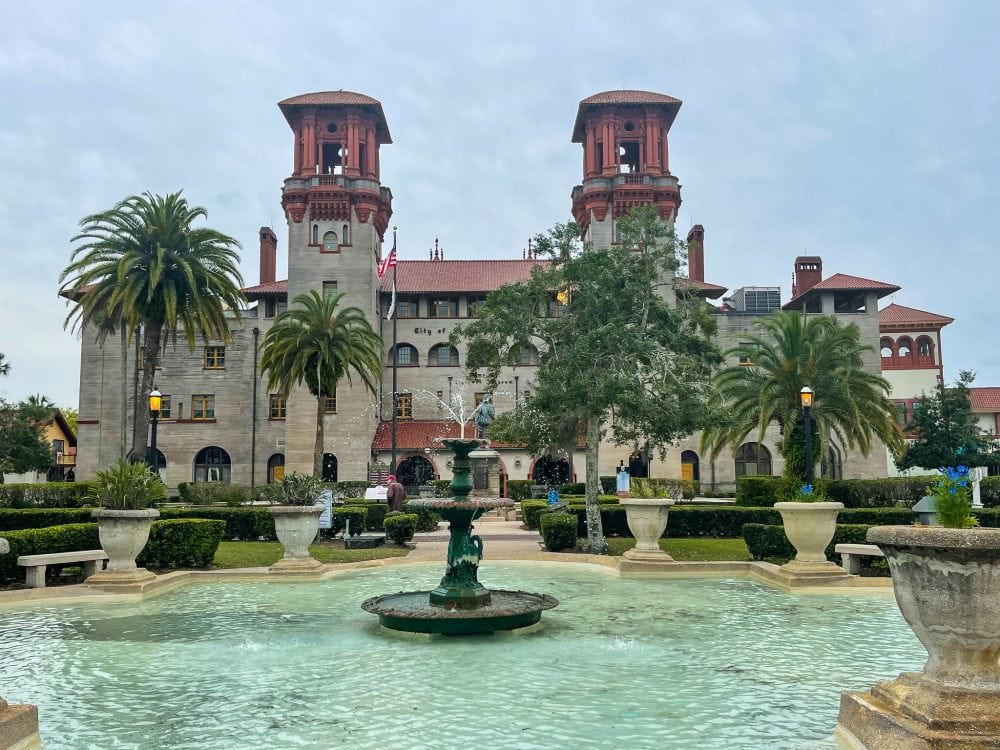
The Lightner Museum is one of the most famous St Augustine museums and is often referred to as the Smithsonian of Florida because of its large collection of artifacts. Occupying the space of the former Alcazar Hotel, which was built in 1887, the site was commissioned by railroad industrialist Henry Flagler. You’ll hear that name pretty much everywhere you turn in St. Augustine.
In its heyday, the Hotel Alcazar, with its Victorian architecture, was one of the finest hotel resorts in the area and was well known for its impressive art collection. During the Great Depression, however, it fell into disuse and disrepair. In 1947, Otto Lightner (a wealthy publisher) purchased the hotel and turned it into a museum. Today, the museum houses immersive exhibits showcasing the finest collections of Spanish Renaissance Revival architecture, art, furniture, and objects.
I loved the cut glass room, a display of cut and engraved glass from the “Brilliant” period of the late 19th and early 20th century. I enjoyed spotting items that were like things I had at home, and I now wonder if all the cut glass dishes, plates, bowls, etc., that I inherited from my grandmother have any value.
Details: Address: 75 King Street, St. Augustine | Official Website
St. Augustine History Museum
As the oldest city in the U.S., there are stories from nearly 500 years of history to tell, and a visit to the St. Augustine History Museum will help you learn how the originally discovered land was shaped into the city you experience today.
The museum features a combination of historical displays and private collections in galleries that showcase the earliest prehistoric settlers, the emergence of the European colonial era, and include the various countries that ruled St. Augustine (England, Spain, France). There is a replica of a Timucan Indian Village, a Florida Cracker trading post, and the popular Spanish sunken treasure room.
Details: 11 Estey Street, St. Augustine | Official Website
Governor’s House Cultural Center And Museum
The Governor’s House is located in the heart of downtown historic St. Augustine, and along with the other historical buildings in the area, faces the central Plaza de la Constitución. This spot has been the place of numerous administrative and political offices throughout the centuries. In the late 16th century it was a residence for governors and later government offices, and at one time, a post office.
Today it is a cultural center and museum and showcases an exhibit of the building’s history, including a timeline from its inception to the present day. It is managed by a University of Florida program responsible for the long-term preservation and interpretation of state-owned historic properties in St. Augustine.
Details: 48 King Street, St. Augustine | Official Website
Villa Zorayda Museum
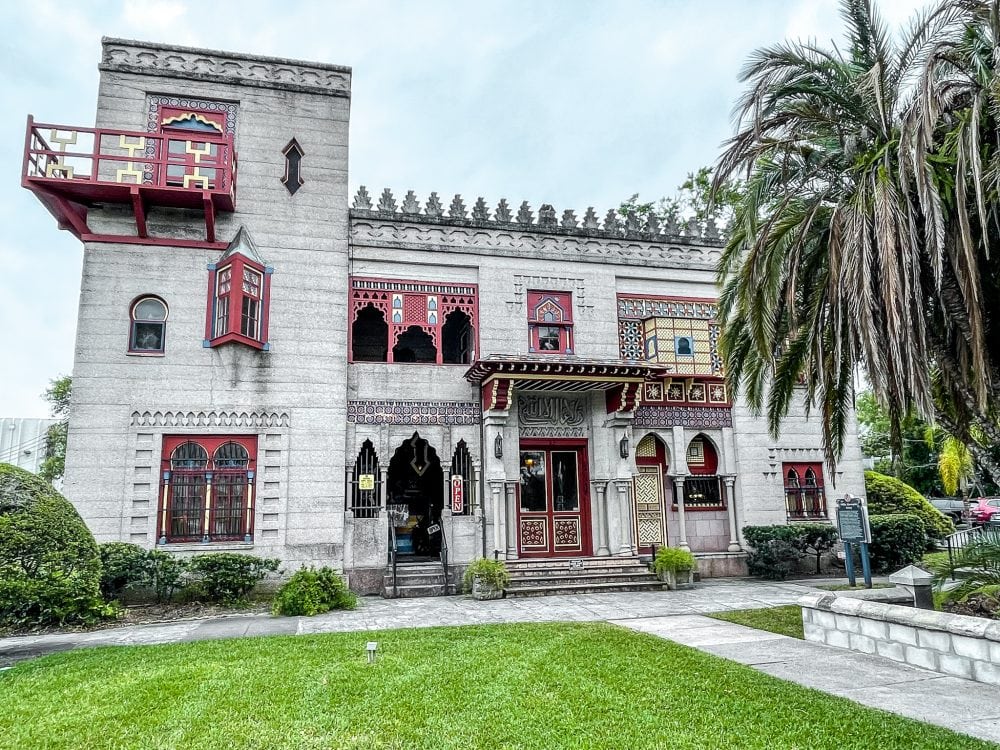
Like the Lightner Museum, Villa Zorayda is also known for its architecture. This 19th-Century villa displays some of the most astounding art and antique collections in St. Augustine in a way that shows off the collections and tells the story of 138 years of villa history. Villa Zorayda was commissioned by Franklin W. Smith in 1883 and was originally built as his winter home. It was inspired by the Alhambra Palace in Granada, Spain, and during the Spanish colonial era, was an attempt to bring a part of Spain to St. Augustine.
Inside, it houses hand-carved inlaid furniture, oriental rugs, a wide variety of Egyptian artifacts, hand-pierced brass lamps, and stunning Arabesque traceries on the walls, which are replicas of the Alhambra. It’s an eclectic mix emblematic of rich history, although the curation and display choices don’t always seem to make sense.
After entering the museum, you’ll pick up a handheld audio device and can listen at the number stops throughout. I think my favorite was the sacred cat rug, entirely woven from cat hair. Rumors claim that the rug is cursed and that anyone who steps on the rug will soon die. The rug is hanging on a wall now, so we’re all safe, but several years ago when it was laying out front of the building, a dead cat was found on it. Believe what you choose.
Details: 83 King Street, St. Augustine | Official Website
Medieval Torture Museum
Perhaps one of the more gruesome museums in St Augustine, and also one of the most fascinating, is the Medieval Torture Museum. It takes visitors back to some of the darkest periods in history, showing torture chambers and the torture devices used to inflict a slow and agonizing death. Who knew that torture was so much fun throughout medieval history.
While I don’t think it’s a particular squeamish museum, parental guidance is suggested.
Details: 100 St George Street, St. Augustine | Official Website
Old Jail Museum
The Old Jail was built in 1891 and served as the town jail until 1953. It was commissioned by Henry Morrison Flagler, the owner of the Hotel Alcazar (now Lightner Museum), and was designed to look like a fine hotel with a jail inside. Flagler didn’t want the jail to disrupt the majestic appearance of the city, so the outside was designed using Romanesque Revival architecture. Inside, though, it didn’t have a bit of comfort and charm. It is listed on the U.S. National Registry of Historic Places.
When visiting the museum, you’ll be guided by costumed deputies through the cell blocks, around the high-security area, and into the Sheriff’s living quarters. Behind the jail, you’ll witness the gallows, where prisoners were hung.
Details: 167 San Marco Ave., St. Augustine | Official Website
St. Augustine Lighthouse & Maritime Museum
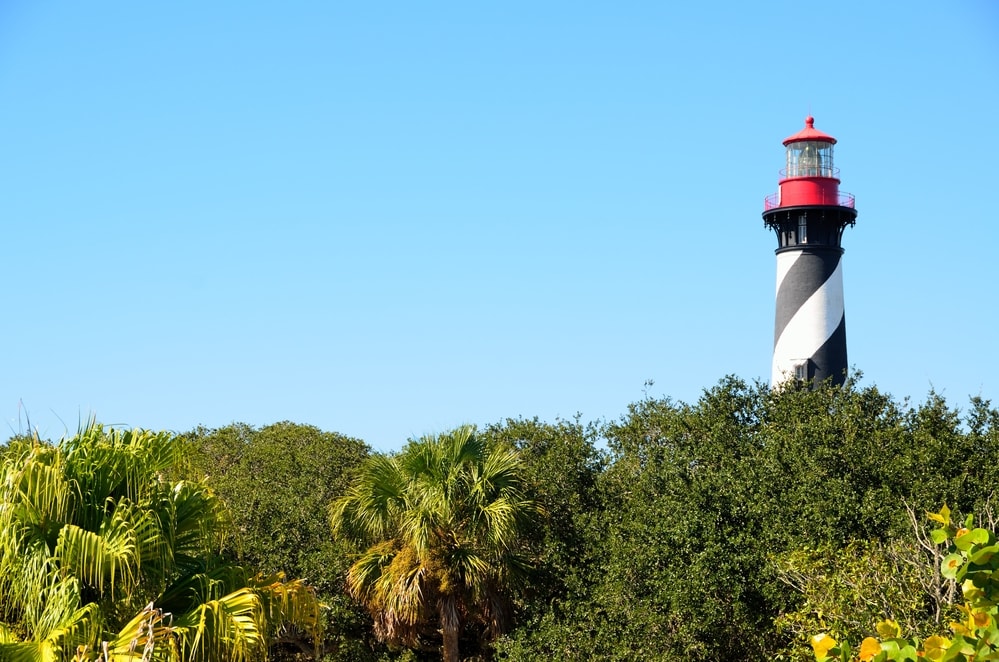
The St. Augustine Lighthouse Station is one of the most iconic historic sites in St. Augustine. Built in 1874, it is the oldest lighthouse in Florida and is found at the northern end of the city near Anastasia Island. With a 165-foot tall striped tower – it’s 219 steps to the top – the lighthouse can be seen from miles away. And from the top are spectacular views of downtown St. Augustine, the water, and beautiful beaches.
Inside, there is a Maritime Museum, that displays exhibits showcasing the lives of former lighthouse keepers and their families, the numerous shipwrecks that occurred here, and how it guarded the coast of St. Augustine during WWII.
Details: 100 Red Cox Dr., St. Augustine | Official Website
St. Augustine Pirate & Treasure Museum
Ahoy, me hearties! Who doesn’t like learning more about these sketchy swashbucklers of the sea and looking at authentic pirate artifacts?!
This family-friendly museum is home to the world’s largest and most authentic collection of pirate artifacts. You’ll see glittering gold jewels, pirate weapons, and other pirate paraphernalia as you learn about how pirates lived over 300 years ago as they sailed from Port Royal, Jamaica, to Flordia.
Details: 12 S Castillo Dr., St. Augustine | Official Website
St. Augustine Shipwreck Museum
The Shipwreck Museum & Gallery houses an array of exhibits that uncover the stories behind some of the world’s most famous shipwrecks. Some on the one included are the R.M.S. Titanic, the Nuestra Señora de Atocha, the 1715 Spanish Fleet, and the S.S. Central America. It also houses a collection of maritime objects from around the world.
Details: 46 Charlotte Street, St. Augustine | Official Website
Lincolnville Museum & Cultural Center
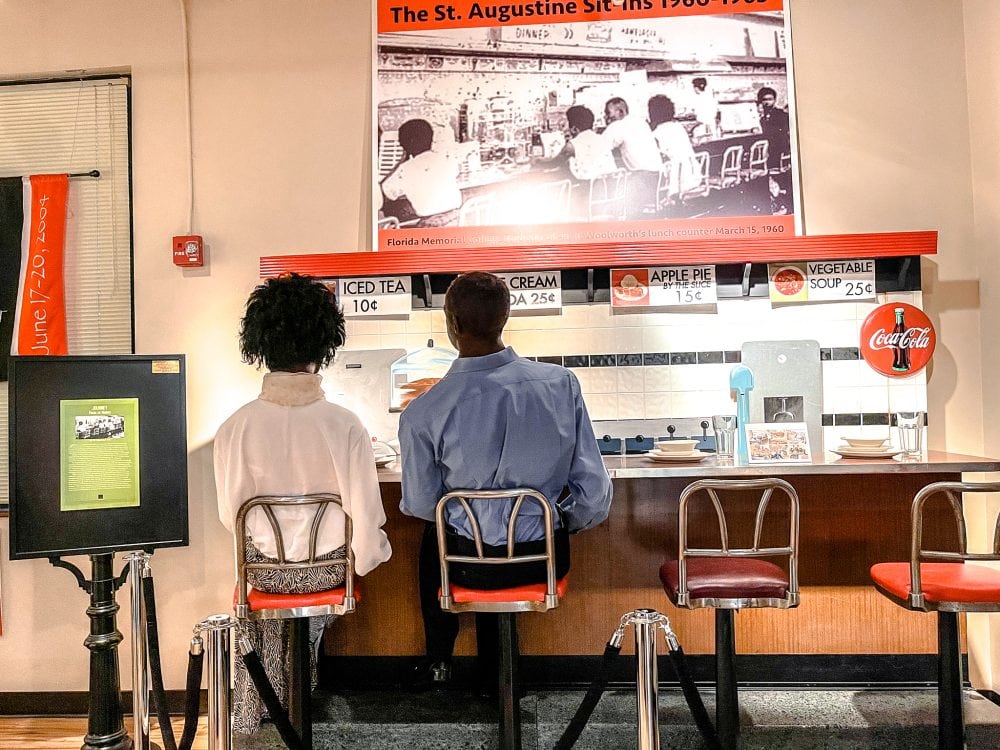
The Lincolnville neighborhood was founded by free Black men and women in 1866 and was the first Black community in St. Augustine. It would come to figure prominently in the Civil Rights movement and today is a great place to learn more about the role the nation’s oldest city played in the movement.
The Lincolnville Museum and Cultural Center is located in the Excelsior School Building, the first public black high school in the county. After desegregation, the school was closed and went through a variety of tenants before its current iteration as a museum and cultural center. The exhibits here chronicle more than 450 years of African-American history in North Florida.
Walking through is both sobering and inspiring. You’ll see the arrest record and restraints used on Rev. Martin Luther King Jr. when he was jailed in St. Augustine. You’ll see the Woolworth’s counter where the St. Augustine Four held a sit-in and were arrested. Learn about the Splash Heard Around the World caused by an irate hotel owner pouring acid into an integrated swimming pool – while swimmers were in the pool. Congress passed the 1964 Civil Rights Act the following day.
While the subject matter is a heavy one, it’s a truthful telling of history. It’s suitable for the whole family and is sure to spark conversations about years of history. There are exhibits honoring local Black residents which is a great way to look at both the ugly and the amazing.
Details: 102 M.L. King Ave, St. Augustine | Official Website
Accord Civil Rights Museum
The Accord Civil Rights Museum is in the Rudcarlee Building. The building was once by Dr. Rudolph N. Gordon, one of the first black dentists and maxillofacial surgeons in Florida. Not only was Dr. Gordon an influential figure in Black History in Florida, but his practice was the first medical office in St.Augustine to abolish racially segregated waiting rooms.
The building was named after the Gordon children, Rudolph (Rud), Carlotta (Car), and Rosalie (Lee) – Rudcarlee.
Gordon died in 1959 and passed the building on to another dentist, Dr. Robert B. Hayling. Hayling was the leader of the local Civil Rights Movement, head of the St. Augustine chapter of the Southern Christian Leadership Council, and an adult adviser to the St. Augustine NAACP Youth Council. He has been considered the father of the St. Augustine civil rights movement.
To mark the 50th Anniversary of the 1964 Civil Rights Act, the building was turned into the Accord Civil Rights Museum. It now features displays, articles, and artifacts that belonged to pioneers and heroes of the 1960s Civil Rights Movement in St. Augustine. The Accord Civil Rights Museum opened in 2014 and has a marker on the ACCORD Freedom Trail.
Details: 79 Bridge Street, St. Augustine | Official Website
Spanish Military Hospital Museum
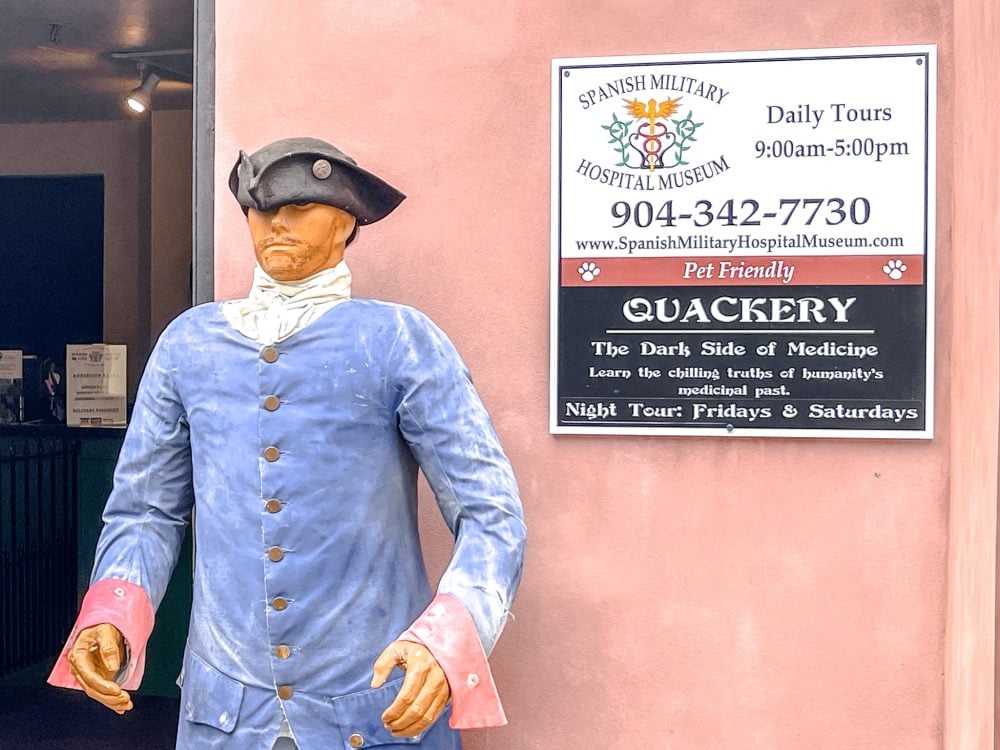
The Spanish Military Hospital Museum takes visitors on a journey back to the Spanish colonial period with exhibits of Spanish military healthcare. The building itself is a reconstruction of a military hospital from the era and is built on the same site as the 1791 original hospital.
Touring the museum is done in small groups led by a costumed character from the era. He explained the various details from the colonial Spanish days of medicine, pointing out antique surgical instruments and demonstrating techniques. While much of it was pretty primitive, they had impressive success with herbal medicines and what we think of as alternative treatments today (and what was all they had back then).
Some of the best museums I’ve visited are small, niche, and often quirky. They hone in on one specific angle – whether that’s a particular topic, era, or subject matter (like Spanish military medicine). It was fun to visit this one, a quick visit of about 45 minutes. Our museum guide shared that most visitors have some connection to the medical industry; he was surprised that of the three in our group, none did. We were all just curious.
Details: 3 Aviles Street, St. Augustine | Official Website
Ximenez-Fatio House Museum
The Ximenez-Fatio House Museum is one of the best-preserved Spanish colonial houses in St . Augustine and shows how people lived after Florida became part of the United States and eventually a state of its own.
The house was built by Don Andres Ximenez in 1798. It features a three-story house, two warehouses, a grocery store, a billiard room, a storeroom, and a tavern. When Ximenez died in 1803, it was passed on to Mrs. Margaret Cook who turned it into a boarding house. The boarding house went through a series of owners, various single women, before it fell into disrepair. The grocery store and storeroom had always survived as retail businesses since they were built.
Today, you can visit the museum and see how each room brings the past to life. As ongoing research and archaeological excavations of the property continue, more of its story emerges.
Details: 20 Aviles Street, St. Augustine | Official Website
Father Miguel O’Reilly House Museum
This quaint little house is one of the oldest in St Augustine, dating back to 1691 during the first Spanish colonial era in St. Augustine. The Museum has three main stories to tell; the story of the house and its creation, the Catholic traditions that evolved in 1565, and the story of the Sisters of St. Joseph who have guarded the O’Reilly House since 1866.
Details: 32 Aviles Street, St. Augustine | Official Website
Peña-Peck House (Woman’s Exchange)
The Peña-Peck House is one of the 35 remaining original houses built during the First Spanish Period (between 1565 and 1763). The house was built in roughly 1750 by order of King Ferdinand VI for his Spanish Royal Treasurer, Juan Estevan de Peña. The house was used as a treasury until 1930 when it was left to the city of St Augustine as a museum.
Today, it brings history to life with its collection of 19th-century art, award-winning ornamental gardens, and antique furnishings. The house is a look at how high society lived during the Spanish colonial era.
Details: 143 St George Street, St. Augustine | Official Website
Oldest Wooden School House
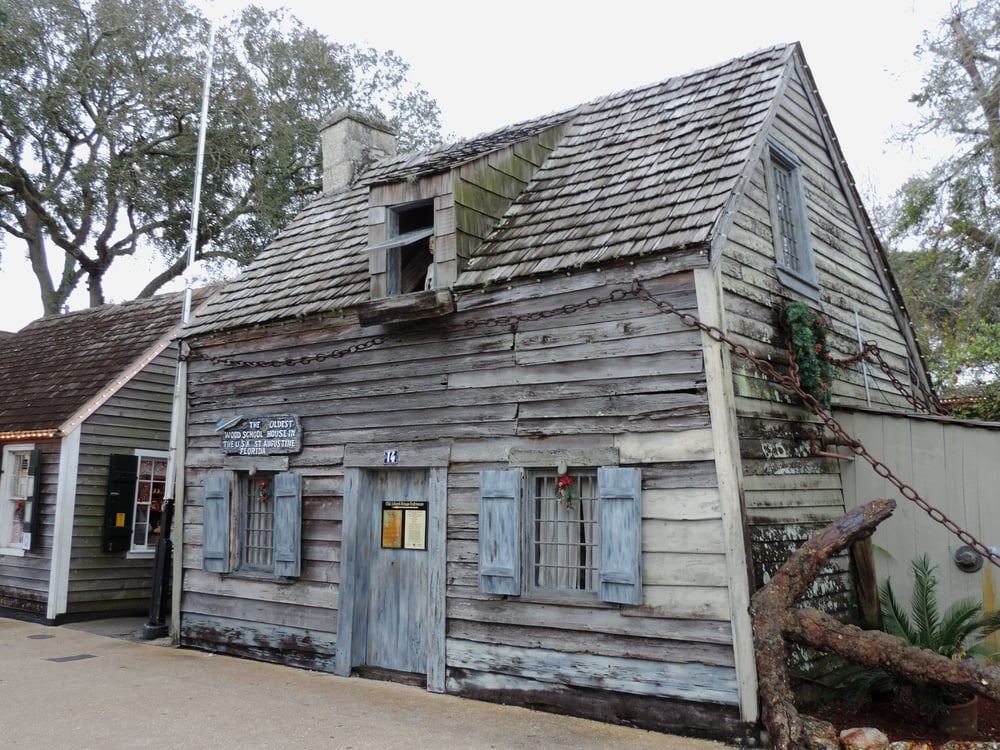
The Oldest Wooden School House is a museum that shows what school life was like in the 1700s. The museum is inside the original building which is over 200 years old Visitors can see old school toys and supplies, and learn about education and teaching from this time period.
Details: 14 St George Street, St. Augustine | Official Website
Oldest Store Museum Experience
Set in a 1908 General Store, the Oldest Store Museum is exactly what it says – an old store. The friendly clerks offer demonstrations of past inventions that were considered to be created during the turn of the century. The General Store sold everything from tonics and elixirs to a goat-powered washing machine.
Details: 161 San Marco Ave., St. Augustine | Official Website
World Golf Hall Of Fame & Museum
The World Golf Hall of Fame showcases the legacy of 160 golfing legends and celebrates the history of the game. It also has a wide collection of golfing artifacts, personal memorabilia from golfing champions, as well as photography and video interactive exhibits. You can also play over 165 courses on a golfing simulator.
Details: 1 World Golf Pl., St. Augustine | Official Website
Ripley’s Believe It Or Not! Museum
The Ripley’s Believe It or Not Museum displays oddities and rarities of the random and amazing objects, including shrunken human heads and rare animals skeletons.
It was founded in 1918 by Mr. Ripley, who was inspired by the tales of people and places that are impossibly hard to believe and yet are true.
There are 29 of these museums around the world, and while some will consider it an attraction and not a museum, I’ve chosen to include it.
Details: 19 San Marco Avenue, St. Augustine | Official Website
Classic Car Museum Of St. Augustine
If you love classic cars, then you will want to take a stop by the Classic Car Storage & Museum in St Augustine. Here you can see cars from the early 1900s to the present, and learn about the history of the automobile and how it transformed through history. Even if you’re not a car buff, this museum is fun.
Details: 4730 Dixie Hwy., St. Augustine | Official Website
Final Thoughts on Museums in St. Augustine
When you visit St Augustine, it won’t take you long before you feel like you’ve stepped back in time as you walk the cobblestoned streets of downtown. History surrounds you – from 16th-century architecture to museums, from the colonial quarter to the Castillo de San Marcos (a National Park), and from the numerous special events found around the city.
For Pinterest
Save these pins to your favorite travel and museums boards. You’ll want to refer to them when planning a trip to St. Augustine, Florida.
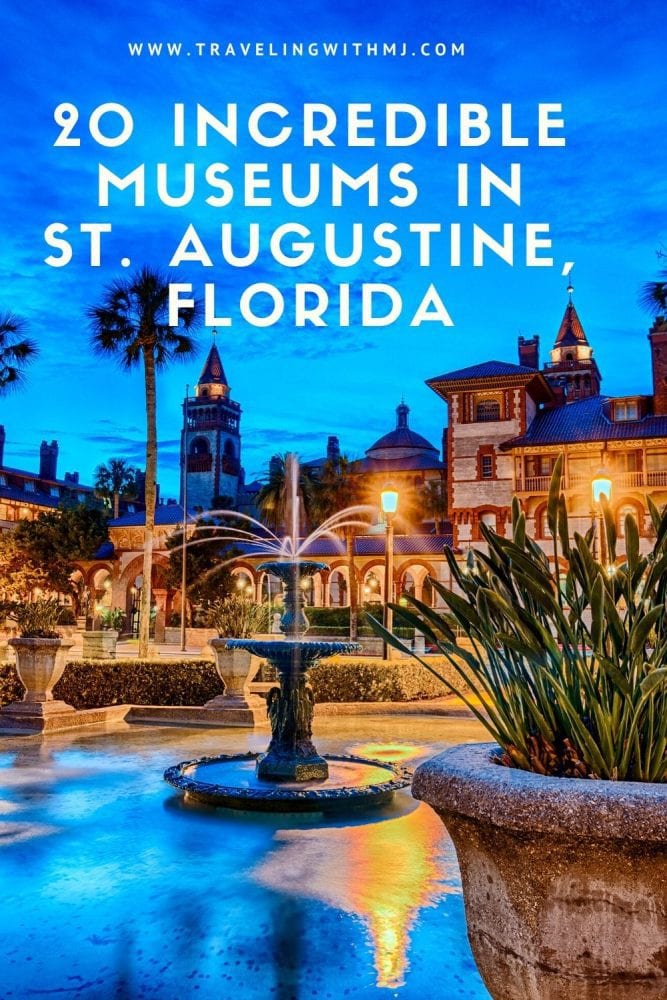
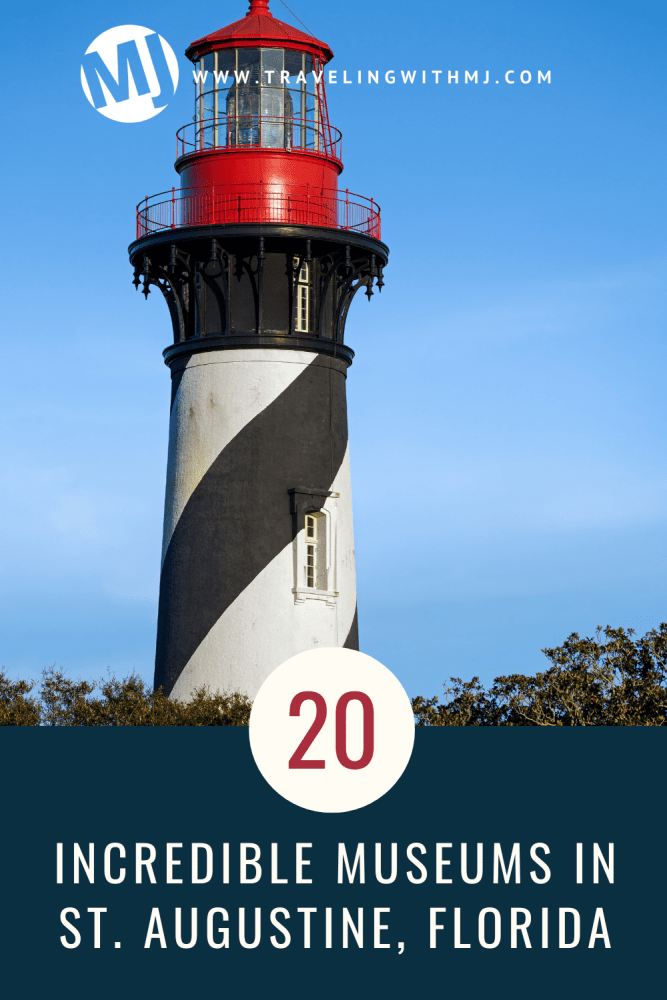
Disclosure: I received a media pass while a business meeting in St. Augustine. The pass provided complimentary admission to many of the museums listed here.

